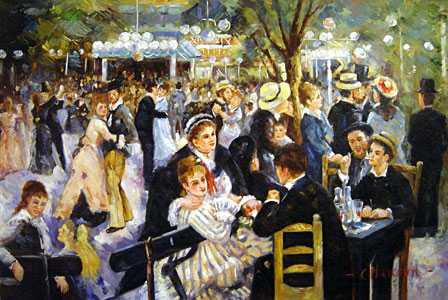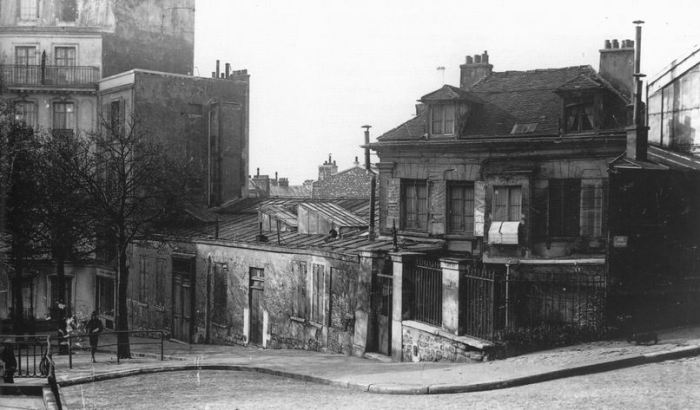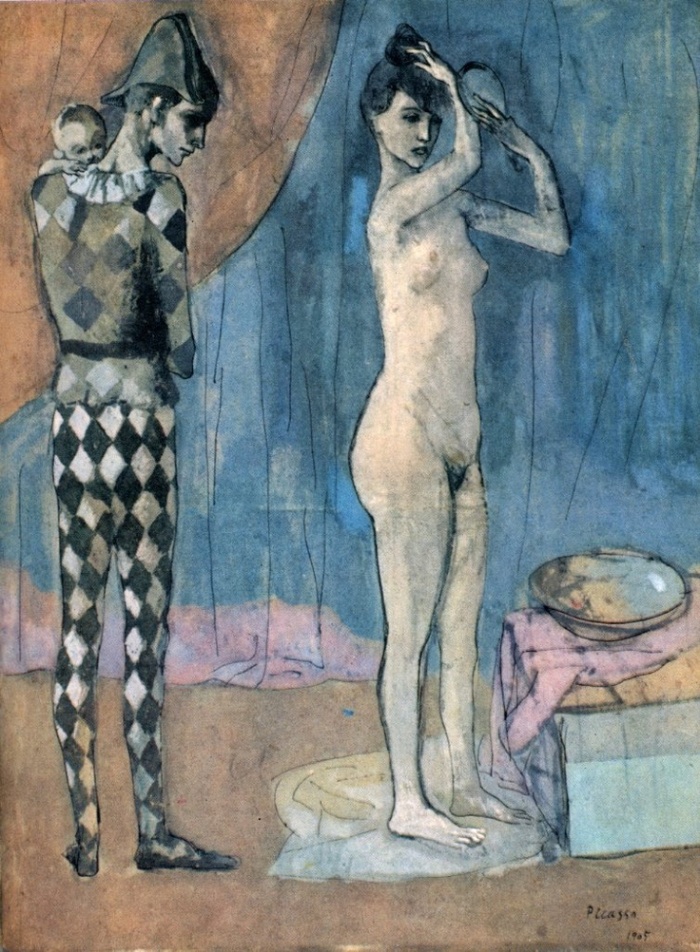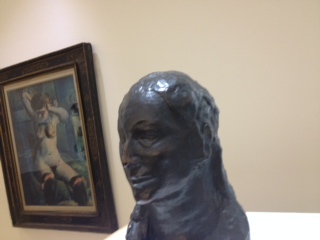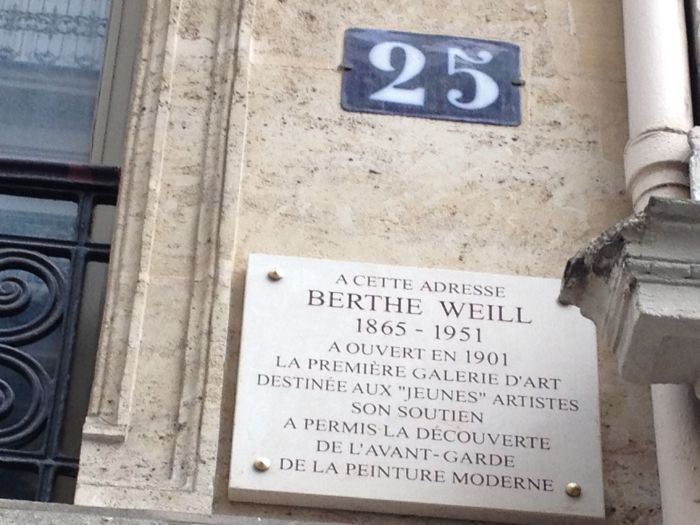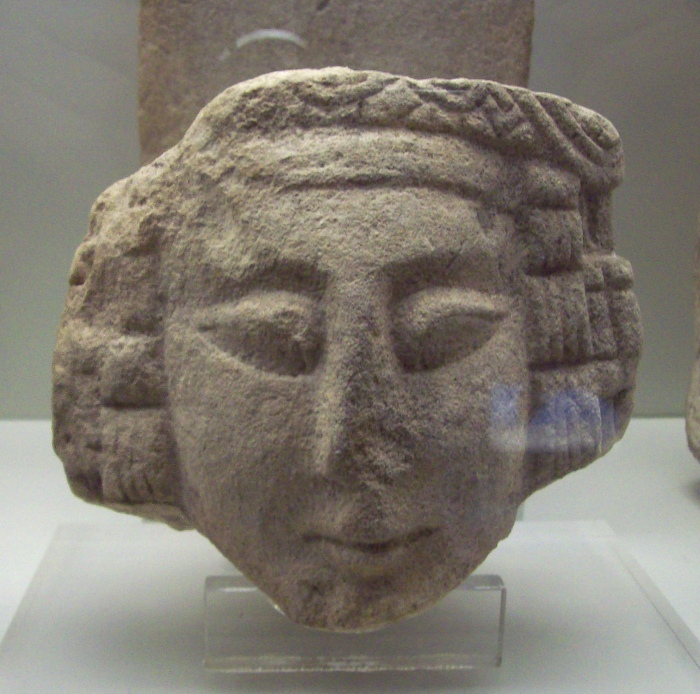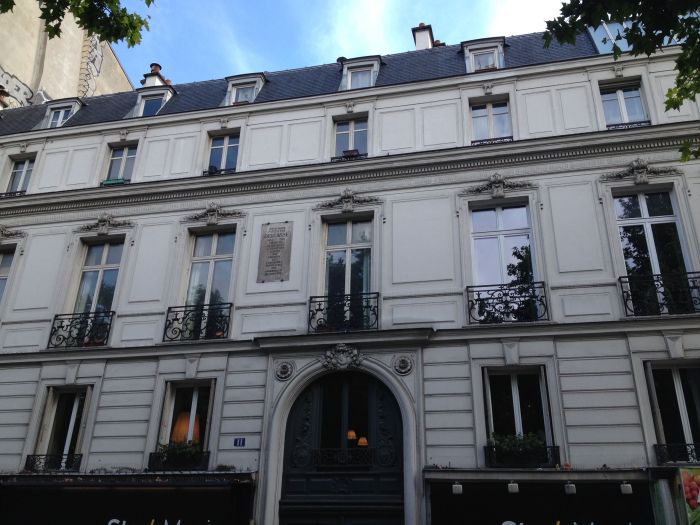1908
The earliest, and most important of Picasso’s Paris paintings, are the scenes of the dancers at Le Moulin de la Galette.
Picasso had come to Paris in 1900 for World’s Fair. He stayed for two months and immersed himself in art galleries as well as the bohemian cafés, night-clubs and dance halls of Montmartre.
Le Moulin de la Galette (1900) by Picasso
Le Moulin de la Galette painting reflects his fascination with the decadence and gaudy glamour of the famous dance hall where bourgeois patrons and prostitutes rubbed shoulders. The painting portrays a crowded floor with dolled up and top hatted clients doing one of the new South American dances.
The painting challenges artists such as Renoir and Toulouse-Lautrec who had both chosen the same subject for their paintings. Instead of using impressionist light in his composition, Picasso favours shadows and reverts to Spainish chiaroscuro.
Dance at Moulin de la Galette (1896) by Renoir
John Richardson, Picasso’s biographer, points out the fact that Picasso, who at the time was new to French art, displays great confidence in pitting himself against these great masters who would have been at the top of their form.
As soon as it was painted, le Moulin de la Galette, was sold for 250 francs to a collecter named Arthur Hue, a publisher of a provincial newspaper in Toulouse.
Picasso, Montmartre
Picasso moved to Paris on his twentieth birthday to develop new art styles and, when he first arrived, he was surprised to see how unhibited couples were as they freely embraced in public. He would not have seen this in his native country accustomed as he was to Spanish restraint. The theme of couples embracing would recur in Picasso’s paintings during those early years in Paris.
Lovers on The Street (1900) by Picasso
Bateau Lavoir
In 1904, Picasso settled in the Bateau Lavoir on place Ravignan (since renamed place Emile Goudeau) where he lived among Bohemian poets and writers until 1909.
This stack of shacks had once been a piano factory and had the appearance of being a one-storey building. However, there were three floors below ground level. It was a labyrinth of corridors and makeshift staircases which contained twelve artists’ studios and thirty rooms in all. Picasso’s studio was at the top of the building.
In her memoirs ( Loving Picasso ), Fernande describes the squalor of Picasso’s living space in the Bateau Lavoir. She tells how there was a large iron stove covered with rust, a black painted trunk which was not very comfortable, canvases and tubes of paint everywhere and there was even a mouse which Picasso like to keep in the drawer of the table.
Bateau Lavoir in the 1900s
The studio would become really hot in the summer time and it was not unusual for Picasso and his friends to strip off their clothes until they were almost naked to combat the heat.
Picasso was notoriously jealous around his women and he forbade Fernande from posing for other artists. He would even go so far as to lock her in whenever he had to leave the Bateau Lavoir so that she would not be able to meet with anybody during his absence. On one such occasion, Picasso locked Fernande into the Bateau Lavoir to go on an errand and the studio caught fire!
The Bateau Lavoir
Fernande Olivier
Fernande Olivier took up with Picasso in 1905 when he was an unknown, relatively poor painter.
An early watercolour paintings of Fernande shows her sleeping as Picasso watches over her. The theme of the sleeper being watched returns in Picasso’s later paintings and Richardson tells us that this theme usually signals a new woman in his life.
Nude with Picasso by her Feet (1903) by Picasso
Clovis Sagot
Picasso did most of his business with an art dealer named Clovis Sagot after moving into the Bateau Lavoir.
On one particular occasion, Picasso was penniless after a trip to Holland and he invited Sagot to come see some of his paintings. Sagot picked out two of his Dutch paintings and another painting – “Girl with a Basket of Flowers“. Sagot offered him seven hundred francs for them. Picasso refused.
Girl with Basket of Flowers (1904)
A few days later Picasso decided to sell the paintings to Sagot after all since he was not only broke, but he also needed to buy himself some art supplies. This time Sagot had the cheek to lower his offer to five hundred francs!
In later life Picasso described Sagot as “being a past master at assessing the exact degree of an artist’s desperation and squeezing maximum benefit from it”. He was, by all accounts, a hard man who exploited many of the Montmartre painters of the time.
Medrano Circus
Picasso adored the circus clowns and enjoyed chatting with them at the bar after the show. Fernande Olivier recalls how he once invited a Dutch clown and his wife, a Polish bareback writer, to dinner.
Picasso found the theatre boring. Instead he enjoyed listening to guitar music, watching Spanish dancers and going to bull fights. Fernande Olivier describes how he liked anything which he was not cut out to do himself, and anything which involved strong colours or characteristic odours.
The circus was located only a few streets away from the Bateau Lavoir and, unlike Degas or Toulouse-Lautrec before him, Picasso never shows a circus ring or audience in his paintings. He prefers to focus instead on a single figure or couple and to use a static image rather than portray movement.
Guillaume Apollinaire
Picasso first met Guillaume Apollinaire in 1904 and, together with Max Jacob, he was key factor in Picasso’s exposure to French culture and the avant-garde in the years before the First World War.
Apollinaire was raised in the gambling halls of Monaco, Paris and the French Riveria and he was one of the charismatic figures in Picasso’s circle.
Guillaume Apollinaire
Apollinaire had published a number of semi pornagraphic books and, according to Richardson, he opened Picasso’s imagination to “the pagan and wider shores of sex and pornography”. He encouraged Picasso to picture himself in different roles which were at odds with conventional society.
The Rose Period
Picasso’s switch from the Blue to Rose period was largely due to the improvement in his fortunes, meeting the beautiful Fernande and leaving gloomy Spain for Paris, the city of lights.
During the Rose period, Picasso directs his attention towards pleasant themes such as carnival performers, harlequins and clowns. He abandons the daunting blue colours for more vivid hues.
The Harlequin’s Family (1905)
Picasso discovered the Saltimbanques one day as he was returning from visiting friends of his family living on the other side of Paris. On the way home, he came across a troupe of acrobats whom he says stayed in his memory.
The memory of the Saltimbanques resulted in Picasso’s huge canvas painting (212 x 229 cm) which shows a group of acrobats on a plain, some of them are resting while the others are working. This is by far the largest painting which Picasso had done so far and it was also the most ambitious.
Family of Salitmbanques (1905)
“Family of Saltimbanques” depicts dusty vagrants rather than real circus performers and, instead of a circus backdrop, we see an expanse of wasteland which probably represents the shanty town which was Montmartre in Picasso’s day.
The nomads in the painting had freedom and skill and Picasso as a struggling artist would have empathised with them.
Boy Leading A Horse
“Boy Leading a Horse” is the paintings which epitomises Picasso’s Rose Period according to Sue Roe.
In this painting, we see a beautiful naked boy approaching leading a white horse with combination of delicate colour and “a mood of awe-inspiring calm”
Boy Leading a Horse (1906)
Paul Gauguin
Early in 1901, Picasso became familiar with some of Gauguin’s work. Paco Durrio was a mutual friend of both artists. Durrio, was a great admirer of Gaugin and he put his kiln at Picasso’s disposal so that he could work in the same way as his hero.
Gauguin died in 1903 which didn’t leave much time for both artists to work together. However, while working on some pottery in Durrio’s studio, Picasso was constantly in the presence of Gauguin’s works. In these early years, he was using the same mediums as the elder painter – wood cuts, ceramic and oil on canvas.
Oviri (1894) by Paul Gauguin
Picasso read with interest Gauguin’s book entitled “Noa Noa”, and he was fascinated by his ideas on art. According to Richardson, this book would be the primary conduit for the primitive power, mystery and drama which Picasso appropriates for his own paintings. Phenomena that interested Gauguin also, more often than not, was of interest to Picasso.
Gertrude Stein
Clovis Sagot introduced Picasso to the wealthy art patrons Gertrude and Leo Stein in 1905 They bought several paintings from him, and he was to be a frequent visitor to their weekly salons on rue des Fleurus. It was at one of these salons that Picasso was introduced to the fauvist painter Henri Matisse.
The Stein’s pavillion in Paris was the only place in Paris where there was a permanent display of all that was best in contemporary art. Picasso’s “Girl with a Basket of Flowers” was one of the first major art investments which Gertrude Stein made with her brother Leo.
Leo and Gertrude Stein were admirers of avant-garde artists and Fernande Olivier recalls how they seemed to have an instinctive flair for it. They bought 800 francs worth of pictures from Picasso on their first visit to Le Bateau Lavoir.
Portrait of Gertrude Stein (1906) by Picasso
Gertrude Stein’s personality and appearance so fascinated Picasso that he asked to paint her portrait in the fall of 1905. The portrait would take the rest of the winter and 90 sittings in total.
Gertrude Stein was unique amongst all the other buyers who took an interest in Picasso’s art in that she cultivated a strong relationship with him based on mutual respect. Richardson claims that Picasso entertained a higher regard for Gertrude Stein than any other woman in knew – with the exception of his mother and his many mistresses.
Gertrude Stein
Picasso used to say of Gertrude Stein and her group of friends – “ils sont pas des femmes, ils sont américains”. Richardson descibes how Gertrude behaved as a modern-minded man. She was, he says, self assured, forthright and disarmingly jovial.
It was because of Gertrude Stein’s daunting personality that Picasso had so much difficulty doing her portrait. He ended up rubbing out her face and starting again. When she claimed that finished painting did not look like her, Picasso told her that eventually it would.
Rivalry between Picasso and Matisse
In her autobiography, Gertrude Stein raccounts the rivalry that existed between Picasso and Henri Matisse. While Matisse’s paintings were shown at the autumn and independent salons (with a considerable following), Picasso’s paintings could only really be seen in her own apartment on 27 rue des Fleurus.
Gertrude Stein’s salon, 27 rue de Fleurus
The challenge of opposites between the two painters would be played out at her soirées. It was a I-can-do-anything-better-than-you rivalry between the two artists. “As different as the north pole is from the south pole” was how Matisse described his relationship to Picasso. They both accelerated the pace of their creativity in order to outdo each other.
The fact that, during those early years living in Montmartre, Picasso had not mastered the French language didn’t do much to help his cause. He found himself conscious of his lack of fluency during Stein’s soirées and was forced to keep quiet. In the meantime, Matisse had what Fernande Olivier describes as “an astonishing lucidity of mind” which must have infuriated Picasso even more. Matisse was, she claims, very precise and intelligent and had the ability to impress people.
Le Bonheur de Vivre (1905) by Matisse
When Picasso saw “Le Bonheur de Vivre” by Matisse , with its orgy of colour, it served to fire him up and to go one better. However, Picasso had not mastered a sense of colour in his paintings. He once said that “the only real colour is black”. He was speaking of the Spanish painter whom he greatly admired – Vélaqsquez.
Later in life, Picasso claimed “in the end, everything depends on one’s self, on a fire in the belly with a thousand rays, nothing else counts” and then he continued to praise Matisse, who he says had the “sun in his gut”.
Picasso and Matisse met regularly and scrutinised each other’s work. “Nobody ever looked at his work as thoroughly as I did” Picasso admitted later in life.
Portrait of Marguerite (1906) by Matisse
After closely examining Matisse’s portrait of his daughter Marguerite, Picasso noticed that, while she was portrayed full-faced, her nose was pointed sideways. Picasso later used the same technique for two central figures in Les Demoiselles d’Avignon.
In the late 1920s Picasso enjoyed provoking the elder artist by painting his own versions of Matisse’s ideas.
Ambroise Vollard
In the Spring of 1906, Ambroise Vollard, one of the greatest art dealers of the 20th century, bought twenty seven paintings from Picasso for 2000 francs. With this money, Picasso and Fernande decided to take their first holiday outside of France together. They took a train to Barcelona in Spain.
Vollard was Picasso’s principal buyer during this period and Fernande Olivier claims he had impeccable taste. He would show up at Picasso’s studio in Montmarte and buy everything as a job lot. She says that the best of these painting were of circus people, scenes of poverty and Salome dancing before Herod.
Tete de Femme (Fernande) (1906)
Berth Weill
Berth Weill was a Jewish art dealer and she opened the first art gallery for avant-garde artists on 25 rue Victor-Massé in Paris. She started out by pedaling prints by artists such as Toulouse-Lautrec. The prints would be pegged like laundry on a clothes line from her gallery window.
Weil prided herself on fairness and she never took advantage of the impoverished artists who came to sell her their paintings. However, once Picasso started to become successful in 1905-1906, he ceased selling his paintings through her.
The Iberian Statues
The Louvre had acquired a group of sculptures which had been executed in the south of Spain at Cerro de los Santos near Seville from the fifth and sixth centuries. These statues were one of Spain’s few contributions to the art of the ancient world and they were of great interest to Picasso. The brutality and the lack of distinction of these statues appealed to Picasso who was by then “anxious to demolish traditional canons of beauty” states Richardson.
During his time in Spain with Fernande, Picasso began to see how he could harness the primitivism of these statues into his work. Away from his friends in Montmartre, in the solitude of the little village of Gosol, Picasso became possessed with a new sense of confidence.
Iberian Statues (6th – 5th centuries B.C.)
Back in Paris, in the hot summer of 1906, Picasso began to approach his work in new ways. He started to work on several woodblocks making sculptures and his paintings depicted carved-looking sculpted figures.
Sue Roe describes how the elongated figures of the Rose Period had given easy to quite a different treatment of the human form. These new figures which Picasso started to paint were more sturdy, they were chunky and their volumes were clearly delineated. The earlier rose palette was “replaced by brick and earth tones”. Not only that, but the the heads of the figures became larger and their shoulders heavier.
Picasso claims that the primitivism in his work, up to and including “Les Damoiselles d’Avignon” stemmed exclusively from the Iberian Sculptures he saw between Spring 1906 and Spring 1907.
Les Demoiselles d’Avignon
I detest people who talk about ‘beauty’. What is beautiful? In painting you have to talk about problems! Paintings are nothing but exploration and experiment. I never paint a picture as a work of art. They are all exploration. I am always exploring, and all this searching and searching follows a logical development. (Pablo Picasso)
Towards the end of the Rose Period, Picasso had begun experimenting with bodily disfiguration but, to his contemporaries, nothing he had done up to this was as radical as “Les Damoiselles d’Avignon“.
“Les Demoiselles d’Avignon” portrays five prostitutes with primal mask-like faces, and it was the precursor to cubism as well as being a visual attack on Matisse’s “les Bonheur de Vivre” the previous year. Matisse responded to this by saying that the painting was a mockery to avant-garde art.
The contrast between the sexuality and femininity together and the way the figures in the painting seem to be wearing “African masks” shocked some of his friends at the time. Some of them declared him insane and even tried to avoid him for a while.
“Les Damoiselles d’Avignon” (1907)
According to Jonathan Jones, modernism began with Picasso’s “Les Demoiselles d’Avignon“. The five ladies staring out the frame of Picasso’s painting all have geometric, angular bodies and Jones notes how the faces with their bulging eyes seem to stare out at the viewer.
Picasso based the faces of the two women on the right on the African totem art that he had collected. He also was familiar with African art following a visit he made to the ethnographic museum in Trocadero with its collection of primitive artefacts on display. Picasso recalls how the museum smelled like a flea market but it opened his eyes to the magic of masks and fetishes. He claimed that if you gave spirits a shape then you could break free from them.
Suddenly I grasped why I was a painter. All alone in that museum, surrounded by masks, Red Indian dolls, dummies covered with dust. The Damoiselles came that day … because it was my first exorcizing picture. (Pablo Picasso)
“Les Demoiselles d’Avignon” can also be seen as Picasso’s reaction against the main stream art trade. He found the impressionist paintings of his contemporaries to be shallow, he had already conformed to expressions of Parisian elegance in his paintings done during the Rose Period. Now that he was earning a stable living, he wanted to attain artistic integrity.
In this kaleidoscope of bodies, there is no central point, no area of stillness or horizon. The viewer is forced to abandon looking for a narrative for this painting. Picasso is experimenting with form, there is no story.
What we see in “Les Demoiselles d’Avignon” is the fruition of his experiments as he moves form the Rose Period to Cubism. According to Anne Baldarassi, Curator of the Picasso museum, it was a game of form with the question of the moment being how to leave the past.
Picasso’s apartment building on 11 Boulevard de Clichy
As Picasso began to make more money on the sales of his paintings, he moved to Boulevard de Clichy overlooking gardens of Avenue Frochot. However, he still continued to hire out his painting workshop in Montmartre because he enjoyed working in that neighbourhood.

